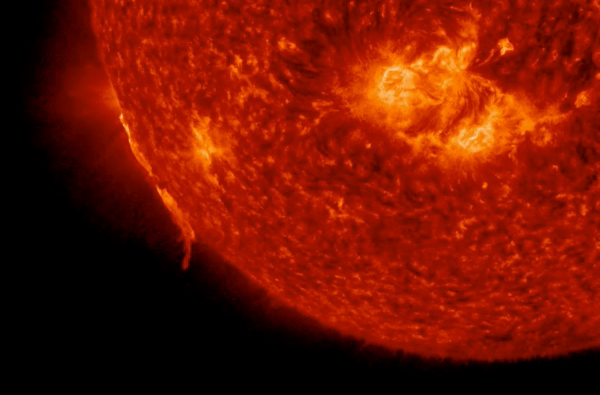The sun fires off its biggest solar flare in more than 3 years
The M4.4-class solar flare was a medium-strength sun storm.

The sun unleashed its most powerful solar eruption in more than three years on Sunday (Nov. 29).
The solar flare, which is a sudden, bright explosion of electromagnetic energy, measured as an M4.4 on the scale astronomers use for sun storms. M-class flares are medium-sized eruptions (compared to small C-class flares and large X-class flares) and rank on a scale from 1 to 9, with larger numbers representing stronger flares.
The M4.4 flare's bright burst was accompanied by a coronal mass ejection, which can often accompany solar flares. Coronal mass ejections are large releases of plasma and magnetic fields from the sun's corona, or its outermost layer.
Related: The sun's wrath: Here's the worst solar storms in history
This flare kicked off a brand new solar cycle (solar cycle 25), which began in December 2019 and was announced in September. The previous solar cycle ran from 2008 to 2019 and, while this new solar activity phase started off with this powerful explosion, scientists estimate that it will be fairly quiet, much like solar cycle 24 before it.
Solar weather follows an 11-year activity cycle and tracking these cycles and the sun's ever-changing activity is critical not just for science but also for our daily lives here on Earth. Solar flares and coronal mass ejections release incredible bursts of electromagnetic radiation. These sudden energy expulsions can be so intense that their effects can reach Earth, causing radio blackouts and other technological disruptions.
But, while X-class solar flares might be capable of causing radio blackouts around the globe, M-class flares like the one we experienced on Sunday typically trigger only minor consequences on our home planet.
Get the Space.com Newsletter
Breaking space news, the latest updates on rocket launches, skywatching events and more!
With this bright burst, X-rays and ultraviolet radiation from the solar flare created a shortwave radio blackout over the Southern Atlantic ocean, astronomer Tony Phillips reported at Spaceweather.com, detailing some of the technological effects of this flare.
Although the flare appeared as an M-class from Earth, it may actually have been a stronger flare, since the event took place partially behind the sun. "The explosion was partially eclipsed by the body of the sun. It might have been an X-class event," Phillips wrote. Spacecraft had a better view of the flare, however, so soon we should have more clarification on the exact size of the event.
Email Chelsea Gohd at cgohd@space.com or follow her on Twitter @chelsea_gohd. Follow us on Twitter @Spacedotcom and on Facebook.
Join our Space Forums to keep talking space on the latest missions, night sky and more! And if you have a news tip, correction or comment, let us know at: community@space.com.

Chelsea “Foxanne” Gohd joined Space.com in 2018 and is now a Senior Writer, writing about everything from climate change to planetary science and human spaceflight in both articles and on-camera in videos. With a degree in Public Health and biological sciences, Chelsea has written and worked for institutions including the American Museum of Natural History, Scientific American, Discover Magazine Blog, Astronomy Magazine and Live Science. When not writing, editing or filming something space-y, Chelsea "Foxanne" Gohd is writing music and performing as Foxanne, even launching a song to space in 2021 with Inspiration4. You can follow her on Twitter @chelsea_gohd and @foxannemusic.
